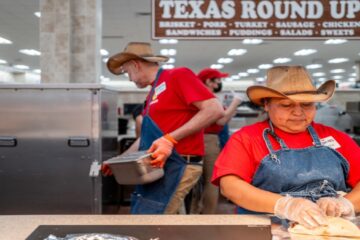One of the most intimidating things to shop for at the moment is groceries.
What used to be a simple trip to the supermarket is now anything but that.
Related: Home Depot launches genius answer to tariff concerns
Even the simple act of parking can feel like a competitive sport.
That’s because most stores have reserved parking that seems to stretch on for miles — and it feels like you need an advanced degree to understand all the jargon.
There’s curbside pick up, drive-up delivery, delivery drivers, online orders, and online or app customers.
Most of these spaces are intended to prioritize customers who pay online and pick up their groceries curbside because they represent guaranteed sales.
Once you actually manage to find a parking spot, shopping the actual store can feel intimidating, too.
Many supermarkets also now offer a whole array of new products to stay competitive.
There’s plant-based meat that looks like meat but pleases the vegan crowd.
There are functional beverages that taste and look like soda but claim to be better for you. And there are seemingly endless options that are free of gluten, carbs, fat, sugar, artificial ingredients, GMOs, grains, lactose, and hydrogenated oils.
And that’s just the beginning.
Grocery stores are in a race for survival.
Image source: Getty Images
Grocery stores are up against the odds
Many supermarkets are getting more competitive with one another not because it’s a part of a fun game, but because it’s a race for survival.
Grocery stores operate on notoriously razor-thin margins. Most make between one to three percent profit — and that’s in the best of times.
More Walmart:
Walmart adds genius new bakery products to take on CostcoWalmart, Lowe’s give customers big gift for spring seasonWalmart retakes key crown (but Costco is coming for it)Walmart makes a major change to delivery service
Most stores make their money in the margins, meaning they have to sell a lot of inventory to actually turn a profit. And many popular items, like bread, milk, produce, and chicken, are actually loss leaders, meaning the store loses money on them.
Plus, customers are incredibly price-sensitive. They can tell when they’re paying too much, and they will go elsewhere.
Which means most supermarkets are engaged in something of a pricing race to the bottom, which further cuts into profits.
Walmart issues important food message
Walmart (WMT) , the largest grocer in the U.S., knows a thing or two about food prices.
The super-retailer has been on a mission in recent years to bring down the seemingly ever-increasing cost of food. In 2024, it announced it would roll back the price of many food staples to pre-inflation levels.
And now, one of Walmart’s biggest issues is tariffs.
Related: Famous fast-food chain closing nearly two dozen locations
President Trump has implemented tariffs on some of our biggest trade partners, including 10% tariffs on Japan, South Korea, and Vietnam, and (temporarily) 30% tariffs on China.
But Walmart has said that keeping food prices low is one of its top priorities, despite how tricky tariffs make that.
“First, we want to keep our food and consumables prices as low as we can,” Walmart CEO Doug McMillon said during the Q1 earnings call. “Food prices in the U.S. have gone up in recent years and our customers have been feeling that all along. We won’t let tariff-related cost pressure on some general merchandise items put pressure on food prices.”
McMillon added that tariffs on some countries, however, will make imported foods a harder puzzle to solve.
“But as it relates to food, tariffs on countries like Costa Rica, Peru, and Colombia are pressuring imported items like bananas, avocados, coffee, and roses. We’ll do our best to control what we can control in order to keep food prices as low as possible,” he continued.


